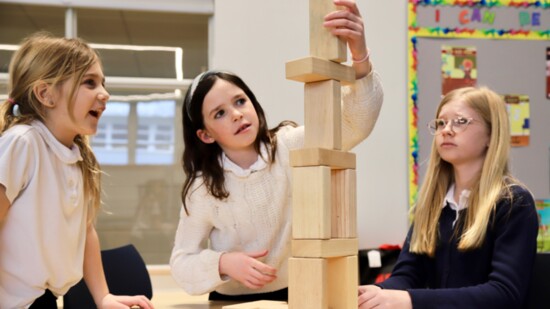Two years ago, Far Hills Country Day School took a bold step: Incorporating a STEAM program that integrates with the curriculum from preschool to the eighth grade.
At its heart is the Learning Commons, a large space equipped with the latest technology that opened in September 2022, thanks to the generosity of donors through the school’s Capital Campaign efforts.
A STEAM (Science, Technology, Engineering, Art and Math) program helps students better understand these subjects and how they interrelate with each other. “This type of education gives students the creativity to build upon what they already are seeing in the real world, to create their own inventions and ensure that when they make mistakes they persevere,” says Brenna Wagner, who directs the school’s STEAM program.
Wagner and Georgia Zaiser, Head of School, discuss the importance of STEAM in a progressive curriculum.
Why is a STEAM program important in education?
Zaiser: Prioritizing STEAM into the curriculum was necessary to further align with our school’s mission. Introducing STEAM programs at an early age empowers students to navigate the increasingly digital landscape with confidence and competence. A STEAM education fosters a hands-on learning approach that transcends traditional classroom boundaries. Through experiential learning opportunities, students are actively engaged, stepping out of their seats to immerse themselves in practical applications of theoretical concepts. This classroom engagement not only deepens their comprehension but also provides them with a tangible sense of value in their collaborative efforts within small group settings.
Wagner: We are building leaders and visionaries. I recently attended the Early Childhood STEM conference in Pasadena, Calif. We discussed how starting STEAM as early as preschool is essential, especially now in our digital age. Students can learn the basics of skills like graphing, tables and geometry at a young age, which will help them be successful later on in their education. The multifaceted approach of STEAM cultivates an array of skills vital for holistic, academic and personal development. Beyond academic proficiency, students emerge from STEAM classes with enhanced critical thinking abilities, honed leadership qualities, adeptness in teamwork and a heightened adaptability to diverse challenges.
Tell us about the Learning Commons.
Zaiser: The Learning Commons is a state-of-the-art technology space. The $1.2 million we raised was designed to support a STEAM curriculum that would span all ages and serve as a space that all students, faculty and staff could utilize. Sitting in the heart of our school, the Learning Commons offers an interactive and flexible space where students and teachers can problem-solve and collaborate. In addition to the learning space created, we have two additional breakout rooms where meetings and brainstorming sessions alike take place.
How does the STEAM program integrate with your current curriculum?
Zaiser: At Far Hills Country Day School, we seek to provide the ideal platform for fostering creativity, critical thinking and problem-solving skills. Our motto is “In Virtute Multi Ascensus,” which translates as “There are many degrees of excellence.” The STEAM program allows teachers to customize for a student’s abilities and needs in a supportive way.
Wagner: We take an interdisciplinary approach. I make sure that what I’m teaching is cross-curricular and collaborate with other teachers. For example, students in Grade 3 are doing a project on states. I’m teaching the students how to create avatars and write a script for the student’s avatar to discuss their assigned state. I have also introduced websites like Canva that both the Technology and Marketing and Communication Departments have decided are essential for the students going forward.
What might students expect to learn in each grade?
Wagner: Coding skills are involved throughout the program. Starting in kindergarten, students use robots to code. Around Grades 2 and 3, they use Chromebooks and iPads to block code online with websites like Codable and Tynker. By Grades 3 and 4, they do block coding to code a robot to follow instructions and interact with them. We also have done some Rube Goldberg engineering, which is very hands-on. Students use different materials that we provide in the Learning Commons to create their own inventions.
In Grades 4 and 5, the students use Google Workspace. They learn how to make Google Slides and Google Documents resulting in maximizing the use of Google Classroom in the most collaborative way among their peers and teachers. In Grades 5 and 6, students use Scratch, and additionally, in Grade 6, they learn 3D printing. In Grades 7 and 8, the students use the 3D printer, use block coding and do robotics.
Older students are tasked with coming up with solutions for real-world problems. For example, we had students create a device to capture an imaginary troll. They collaborated on designing box traps and mousetraps using math and science skills combined with materials like boxes, strings and pipe cleaners. Group projects like this teach them how to have disagreements and compromise. It’s wonderful to see them light up with an idea.
Since the program was initiated, what are the changes you have seen in the student body?
Zaiser: Since the implementation of the STEAM program, the evolution within the student body has been truly remarkable. Notably, there has been a visible rise in both leadership acumen and collaborative teamwork skills. It's been rewarding to witness students embracing these qualities, as they not only excel within our program but also emerge as confident leaders poised for success in high school and beyond. The STEAM curriculum serves as a robust foundation, empowering our students to navigate challenges with resilience and to inspire others through their innovative thinking and collaborative spirit.
Learn more at fhcds.org.
This type of education gives students the creativity to build upon what they already are seeing in the real world.
Through experiential learning opportunities, students are actively engaged, stepping out of their seats to immerse themselves in practical applications of theoretical concepts.
Since the implementation of the STEAM program, there has been a visible rise in both leadership acumen and collaborative teamwork skills.
